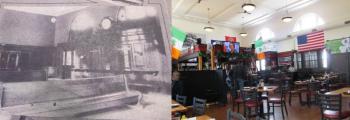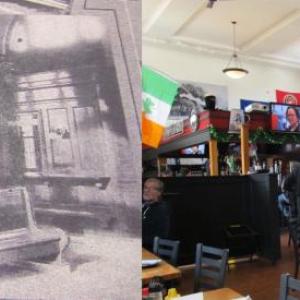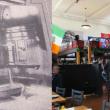Rockland’s Railroad Station turns 100 this month
 A blurry image courtesy Rockland Historical Society of what the interior of the station looked like 100 years ago and a photograph of what Trackside Station Bar & Restaurant looks like today. Note: the absence of the clock and ticket counter. (Photo by Kay Stephens)
A blurry image courtesy Rockland Historical Society of what the interior of the station looked like 100 years ago and a photograph of what Trackside Station Bar & Restaurant looks like today. Note: the absence of the clock and ticket counter. (Photo by Kay Stephens)
 A blurry image courtesy Rockland Historical Society of what the interior of the station looked like 100 years ago and a photograph of what Trackside Station Bar & Restaurant looks like today. Note: the absence of the clock and ticket counter. (Photo by Kay Stephens)
A blurry image courtesy Rockland Historical Society of what the interior of the station looked like 100 years ago and a photograph of what Trackside Station Bar & Restaurant looks like today. Note: the absence of the clock and ticket counter. (Photo by Kay Stephens)
ROCKLAND—Today, if you walk through the doors of Trackside Station Restaurant in Rockland, you’ll see a U-shaped bar on one side, a host of tables on the other and locals enjoying a meal or a drink. Known for being a comfortable watering hole, it’s a good place to watch Sunday football on the giant TV screens.
Zip back 100 years ago to March, 1918. Construction on a brand new train station had begun the year before and had just been completed. The Rockland Courier Gazette published an article on Friday, March 15, 1918, offering details of the new station with the teaser opening sentence: “If present plans materialize the 8 ‘o clock passenger train next Monday morning will pull out of the new station...” making the official opening to the train station presumably March 18, 1918.
The building had just been built by the Maine Central Railroad to be its terminal depot from Portland to Rockland. Back then, the construction of the Georgian style building on the corner of Union and Pleasant streets had required an entire street to be eradicated. In order to lay down tracks, a side street called Portland Street (between Park and Pleasant), had to be torn up and approximately eight houses had to be relocated.
The entire project of buying the land and building the brand new passenger station cost $125,000, constructed with Vinalhaven granite as the base, tapestry brick for the main structure, Indiana limestone for the trim and copper gutters and a steel roof covered in slate. The main entrance on Union Street welcomed passengers with a dramatic arch and overhang and massive limestone columns.
To walk into the trackside entrance on the north, you’d enter a cavernous room with 21-foot-tall ceilings and beautifully finished in quartered oak with round arch multi-paned windows letting in the daylight.
The little details would have been noticeable: A terrazzo floor and terra cotta walls and a stucco ceiling. From the ceiling hung five pendant electric lights. Three massive oak double-sided settees in the center of the waiting room served as the main lobby’s seating with fixed oak benches along east and south walls.
The station could seat up to 200 people with additional seating on the western side in the lavatories, or what newspapers of the day euphemistically called the ladies’ “retiring room” and the men’s “smoking room.”
The Rockland Courier Gazette provided more detail: “Both are commodious apartments, provided with quartered oak settees, and walls tinted to correspond with those in the large waiting room. The lavatories connected with each of the above mentioned rooms are equipped with marble floors, plate glass mirrors and the very latest method of plumbing.”
The ticket office was to the left of the trackside entrance and the western end of the building housed the baggage room—considered to be the largest that the Maine Central Railroad possessed “with a granolithic floor, warranted not to scratch or dent...”
The railway station was also built with a basement. Constructed of fireproof concrete, it contained a heating plant, storage room and a coal pen with the capacity for 40 tons of coal. To heat the building one had to start a fire in the large sectional boiler with 1,500 pounds of coal.
Today, the marble-terrazzo floor still exists under the modern floating wood floor. Evidence of the original floor, although very discolored, can be seen in the kitchen and in the hallway leading to the current bathrooms. The bathrooms at the time were located where the kitchen is now. When the floor in the kitchen was clean, prior to the restaurant moving in, one could see the outline of the toilets on the floor. The location of the current bathrooms was open space on the west end of the waiting room. As for the coal pen in the basement, the metal grate covering the old access port for the coal bin still exists on the Pleasant Street side of the building.
Related story: The History of Rockland's Train Stations
By Gil Merriam
Gil Merriam, a historian and volunteer at the Rockland Historical Society, remembers as a little boy, stopping into the old station on his way to school. “I was around nine or 10 and a few kids and I would walk every day to the Grace Street School and stop at the train station to get a gumball from the gumball machine,” he said. “We used to get there to watch the 8:05 go out, the first passenger train of the day to Portland—the smoke and steam from the coal-fired engine belching out. When we were older, some of us made extra money helping unload the baggage or cleaning the passenger cars.”
“This train station has had several lives,” said Merriam. “In 1959, the Maine Central Railroad stopped scheduled passenger service because use had rapidly declined in favor of the automobile.” After passenger service ended on the line, the station was renovated and adapted for use as Rockland’s city hall, and the baggage area served as the space for the police station after it relocated from Spring Street, [now Museum Street] occupying the building until1996. In the basement, jail cells were constructed, which still exist today.
Merriam’s related story (click on link in sidebar above) details the evolution of the building over the years.
In 2008, a historic restoration of the building’s exterior took place under the watchful eye of the Maine Historic Preservation Commission. Inside, the old station had undergone an entire renovation, resulting in the new bar, the current lights and fans, the floating wood floor over the terrazo, and the red and black paint scheme.
In 2009, Trackside Station Restaurant, currently owned by Mike Woods, opened to the public.
“People come in here all of the time who grew up in the area and still remember the old train station,” said Kelly Woods, Trackside Station Restaurant’s former co-owner and current General Manager. “It has a lot of cool history, such as the jail cells that are still in the basement. Coming up on our ninth year here, we are happy to be part of such a historic building.”
Today, the Rockland Historical Society (in the lower level of the Rockland Public Library) serves as an important source of information about the train station, with maps, photos and even a glass display of some of the vintage train tickets and ephemera. Later this year, Rockland Historical Society, Trackside Station Restaurant and Rockland Main Street Inc. are all planning a formal celebration of the train station’s 100th anniversary.
Additional historical references in this article were provided by Gil Merriam, Rockland historical Society and Gordon Page Sr., Executive Director, Rockland Main Street.
Kay Stephens can be reached at news@penbaypilot.com
Event Date
Address
United States



























